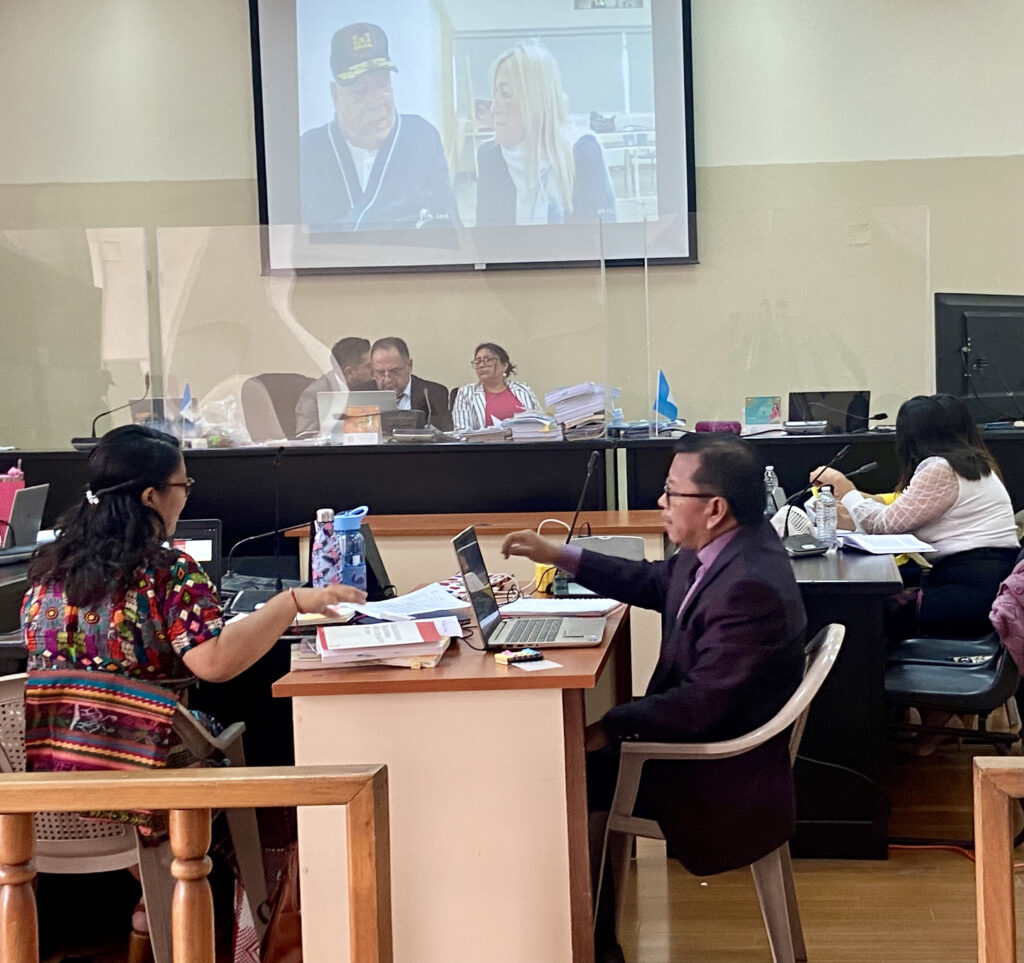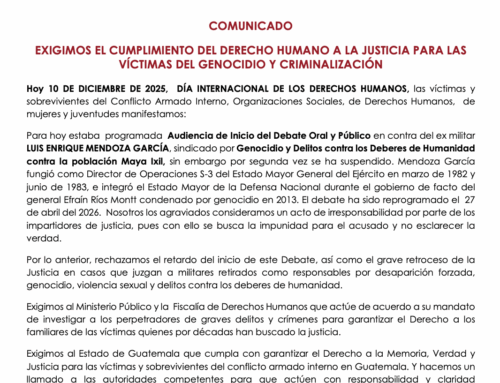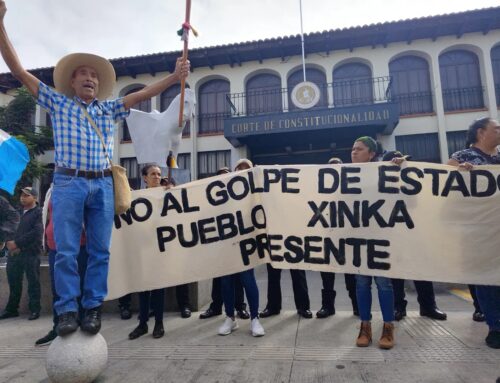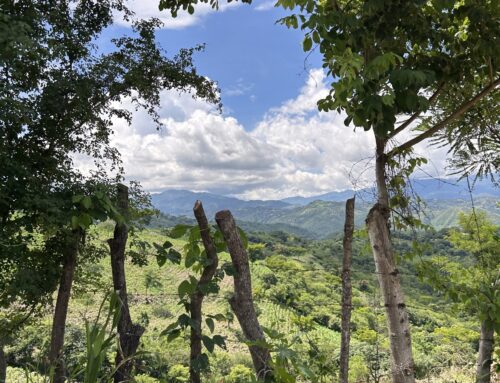November 7th
The defense of the accused, the General Manuel Benedicto Lucas García, sought to delay the trial by soliciting an expert witness from the National Institute of Forensic Sciences (INACIF) to confirm that 5.56 caliber ammunition was used exclusively by the Guatemalan military during the Internal Armed Conflict. However, the High Risk Crimes Court A rejected the petition, stating that the request should have been brought forward during the declaration of the corresponding expert witness and that at this phase it was not novel nor useful to the process.
After this resolution, Lucas García’s lawyer Carmen Ileana Peralta Marroquín presented an appeal for reconsideration. This was also dismissed by the judges, who reiterated that the rights of defense were not violated.
The Public Prosecutor’s Office (MP) presented their conclusions in the case against Lucas García. They began by naming that, over 9 months and 94 hearings, 55 expert witnesses, 76 witnesses, 954 documents, and material evidence had been presented. They argued that planning and executing the systemic attacks against the Maya Ixil population during the Internal Armed Conflict was Lucas García’s responsibility as Chief of the General Staff of the Army. These attacks included 19 massacres, 28,084 victims, 1,084 deaths, at least 26 victims of sexual violence and 11 of torture, and the displacement of 27,000 people.
According to the prosecutors, Lucas García, as third in command, “designed, redirected, approved, managed, and supervised” the counterinsurgent strategy of the Army. Through the creation of task forces he increased the movement of troops in the area, gravely affecting the rights of the Ixil people. The prosecutor Mercedes Morales Santos highlighted that Lucas García had full knowledge of the operations in the Ixil area and “with one single verbal or written order given by his person the destruction of the Maya Ixil ethnic group would have stopped.”. Furthermore, Lucas García expressed in public interviews that the war was a means of reducing the population, justifying the extermination of the peoples in the Ixil region.
The MP proved the crimes of genocide, crimes against humanity, and forced disappearances. They divided the operations into two phases: the pre-emptive phase (August 16th to December 31st, 1981), in which 16 criminal offenses and two selective massacres took place, and the phase of intervention and sweep operations (January 1st to March 24th, 1982), in which there were 19 massacres and 851 victims. The MP determined that the crimes of genocide and forced disappearances occurred during the second phase. Out of the 50,000 inhabitants of the Ixil area, 56.17% suffered direct harm and 43.83% were affected indirectly.
The prosecutor asked for a sentence of 30 years of prison for crimes against humanity, 30 years for genocide, and 40 years for each of the 70 accredited cases of forced disappearances, totaling 2,800 years.
Afterwards, the lawyers representing the Association for Justice and Reconciliation (AJR) started the presentation of their conclusions, in which the lawyer Jovita Tzul paid homage to the victims, many of whom died before or during the trial. The representative of the plaintiffs stated that it had been shown that during the Internal Armed Conflict the government of Guatemala deployed military operations with the objective of eliminating the “internal enemy.” This was the context of the massacres in which 83% of the victims were Maya and 93% were the responsibility of the State.
Furthermore, Tzul said that it was proven that, under the command of Lucas García as Chief of the General Staff of the Army, indiscriminate operations were conducted against the Maya Ixil people which resulted in massacres, forced disappearances, sexual violence, displacement, and persecution. The representative added that during the command of the accused, it was verified that 56% of the civilian population in the Ixil area were victims of the violence carried out by the military. Solely between January and March of 1982, they committed 19 massacres with 1,084 victims, they razed 19 communities, they sexually abused at least 16 women, they tortured 11 people, and 68 communities were displaced.

Representing the AJr legal team, lawyer Jovita Tzul prepares to give their conclusions. Picture: NISGUA
November 8th
The second round of conclusions began with an unusual request by the defense of Manuel Benedicto Lucas García: his lawyer, Teresa Martínez, asked that the military Óscar Platero Trabanino, former vice president of the far-right organization Foundation Against Terrorism (FUNDATERROR) and author of The Farce of Genocide in Guatemala, participate as a consultant in the conclusions. The High Risk Crimes Court A rejected this petition, as argued by the Public Prosecutor’s Office and the plaintiffs.
This matter delayed the presentation of AJR lawyer Jovita Tzul, who resumed her conclusions outlining how the Army pursued the destruction of the “local administrative political organization” (OPAL), which was linked to the Ixil people. Citing expert witnesses, Tzul argued that this persecution had a genocidal intention, backed by massacres, forced displacement, sexual violence, and torture.
The lawyer mentioned the expert testimony of Elizabeth Oglesby, which documented the massive displacement of the Ixil people, and the testimonies of the victims, which reaffirmed the destruction of towns and acts of violence which profoundly affected the people. She cited the protected military Witness A to prove that the witness’ descriptions of certain attacks corresponded with the spider web operations carried out by the Army. She shared that in one massacre, 76.3% of the victims were killed by violent impact, which according to expert documents shows that “these people were not killed in combat; these people were executed”.
Tzul dedicated a portion of her conclusions to sexual violence, explaining that it constitutes genocide when it is linked to the intention to destroy members of an ethnic group. She described six patterns of sexual violence—rape, forced nudity, collective and public sexual violence, sexual violence against children and girls, public exposition of women’s bodies, and aggressions which limit reproductive capacity—and stated that 83.3% of Maya women were victims of sexual violence during the Internal Armed Conflict. She concluded that sexual violence broke social ties, damaged the Ixil people’s identity, and was used as a weapon of war.
Based on the scientific evidence and witness reports, she concluded: “This does not have another name. It is called genocide.” Tzul outlined the necessity of a conviction, stating that the victims have sought justice for 40 years and that a guilty verdict would serve to restore dignity to the Maya peoples, especially the Maya Ixil people, and to ensure that these acts are never repeated. Finally, she asked for a penalty of 30 years for genocide, 30 years for crimes against humanity, and 40 years for each case of forced disappearance, totalling 2,860 years.
Afterwards, the defense requested time to prepare their conclusions, which was granted by the judge Gervi Sical, who scheduled the next hearing for the following Monday, November 11th.
This update is based on court observation and information from Verdad y Justicia





Leave A Comment